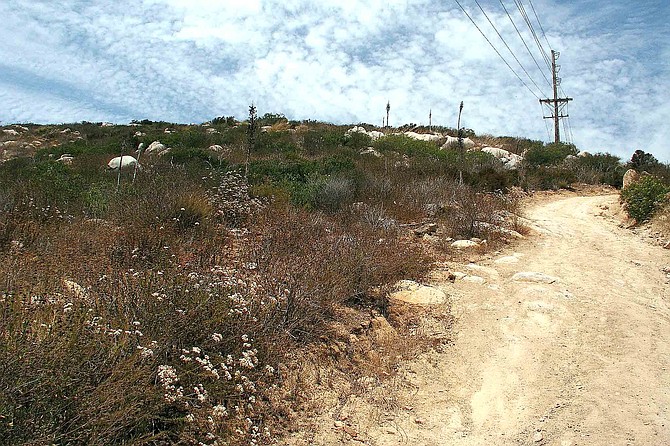 Facebook
Facebook
 X
X
 Instagram
Instagram
 TikTok
TikTok
 Youtube
Youtube

The Chaparral, the tangled assortment of low-growing, drought-resistant, native shrubs covering most of San Diego County’s lower mountain slopes, has managed to remain fairly attractive this summer. Unlike many of the scrubby natives near the coast, chaparral plants tend to hang on to their leaves year-round. This month, the coppery, sun-burnished remnants of last spring’s flower clusters are still clinging to the tips of buckwheat and chamise plants, and a few wildflowers have popped up here and there in response to scant thunderstorm activity over the mountains. To enjoy the beauty of the chaparral landscape, explore the hillsides above Lake Morena and along Lyons Valley, Japatul, and Boulder Creek roads in East County. Or head inland from Escondido toward Ramona or Valley Center.

Warm Water Temperatures, into the 70s Fahrenheit over the past several weeks, won’t last much longer. As fall approaches, shorter days and increasingly oblique solar radiation will mean that less and less energy will be supplied to the ocean waters offshore. These waters will soon be shedding more thermal energy than they receive, thereby keeping the coastal area comfortably balmy for several weeks after the end of the summer-vacation season. Don’t give up on the beach after Labor Day, though — the water’s only a bit cooler, and the beaches are relatively uncrowded.

The Waxing Crescent Moon phase began Saturday, August 27, and ends Saturday, September 3 when it reaches its quarter. This week, the thickened crescent moon will lie in a favorable southerly position for evening telescopic viewing. September evenings in San Diego are often a perfect time to turn a telescope on the moon and note its hundreds of visible craters. Calmer weather conditions this time of year tend to minimize atmospheric turbulence over San Diego’s coastal and inland areas, and that contributes to crisper telescopic views.
The Planet Venus will continue to play its current role as “evening star” for another few weeks. You can spot it rather low in the west-southwestern sky as darkness gathers. Turn a small telescope on Venus, and you will discover that it now shows a crescent phase. By mid-October Venus will vanish from the evening sky, only to be reborn as a “morning star” during the first week of November.
The above comes from the Outdoors listings in the Reader compiled by Jerry Schad, author of Afoot & Afield in San Diego County. Schad died in 2011. Planet information from SkyandTelescope.org.


The Chaparral, the tangled assortment of low-growing, drought-resistant, native shrubs covering most of San Diego County’s lower mountain slopes, has managed to remain fairly attractive this summer. Unlike many of the scrubby natives near the coast, chaparral plants tend to hang on to their leaves year-round. This month, the coppery, sun-burnished remnants of last spring’s flower clusters are still clinging to the tips of buckwheat and chamise plants, and a few wildflowers have popped up here and there in response to scant thunderstorm activity over the mountains. To enjoy the beauty of the chaparral landscape, explore the hillsides above Lake Morena and along Lyons Valley, Japatul, and Boulder Creek roads in East County. Or head inland from Escondido toward Ramona or Valley Center.

Warm Water Temperatures, into the 70s Fahrenheit over the past several weeks, won’t last much longer. As fall approaches, shorter days and increasingly oblique solar radiation will mean that less and less energy will be supplied to the ocean waters offshore. These waters will soon be shedding more thermal energy than they receive, thereby keeping the coastal area comfortably balmy for several weeks after the end of the summer-vacation season. Don’t give up on the beach after Labor Day, though — the water’s only a bit cooler, and the beaches are relatively uncrowded.

The Waxing Crescent Moon phase began Saturday, August 27, and ends Saturday, September 3 when it reaches its quarter. This week, the thickened crescent moon will lie in a favorable southerly position for evening telescopic viewing. September evenings in San Diego are often a perfect time to turn a telescope on the moon and note its hundreds of visible craters. Calmer weather conditions this time of year tend to minimize atmospheric turbulence over San Diego’s coastal and inland areas, and that contributes to crisper telescopic views.
The Planet Venus will continue to play its current role as “evening star” for another few weeks. You can spot it rather low in the west-southwestern sky as darkness gathers. Turn a small telescope on Venus, and you will discover that it now shows a crescent phase. By mid-October Venus will vanish from the evening sky, only to be reborn as a “morning star” during the first week of November.
The above comes from the Outdoors listings in the Reader compiled by Jerry Schad, author of Afoot & Afield in San Diego County. Schad died in 2011. Planet information from SkyandTelescope.org.
Comments